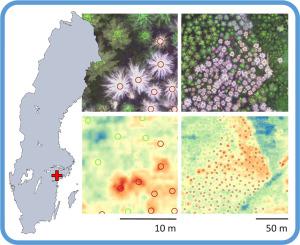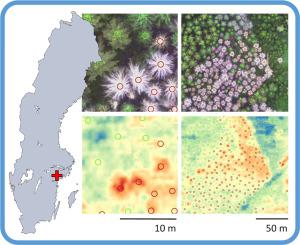Bark beetles as microclimate engineers – thermal characteristics of infested spruce trees at the canopy surface and below the canopy
IF 5.7
1区 农林科学
Q1 AGRONOMY
引用次数: 0
Abstract
Over recent decades, Spruce bark beetle outbreaks have expanded and intensified across Europe, driven by a warming climate and more frequent drought events. While research has largely focused on early detection and vulnerability prediction, little is known about the consequences of beetle infestations on forest microclimates. Bark beetle attacks are expected to alter forest microclimates due to changes in canopy cover, albedo, wind patterns, and evapotranspiration. We explored the effect of bark beetle attacks on summer forest microclimate using two approaches.
Firstly, we measured understory microclimate at 2-m height in 31 Swedish forest stands using small temperature loggers. Along a gradient of attack severity, represented by increasing proportions of attacked spruces, maximum summer day-time temperatures increased by up to 2°C, with this warming effect being moderated by the presence of deciduous broadleaf trees. Surprisingly, night-time minimum temperatures were not affected by bark beetle attacks.
Secondly, we mapped canopy surface temperature over one part of the study area using multispectral and thermal drone imaging, contrasting canopy temperatures of living and dead trees. We observed that dead trees were generally warmer than living trees, by an average of 2.6°C on a sunny day and 0.7°C on a cloudy day.
Our study documented changes in thermal regimes in both the understory and overstory after bark beetle attacks, indicating that climate-change related disturbances are fueling rapid increases in microclimate warming. However, even dead forest stands may function as thermal buffers for understory vegetation, as we found minimum temperatures being unaffected by bark beetles. Finally, our results suggest that increasing the proportion of deciduous trees can decrease the risk of bark-beetle induced microclimate warming. The insights gained can guide forest succession and regeneration management after disturbances, contributing to critical decisions on conservation areas and salvage logging strategies.


作为微气候工程师的树皮甲虫——在树冠表面和树冠下受感染的云杉的热特性
近几十年来,在气候变暖和更频繁的干旱事件的推动下,欧洲各地的云杉树皮甲虫疫情扩大并加剧。虽然研究主要集中在早期发现和脆弱性预测上,但人们对甲虫侵扰对森林小气候的影响知之甚少。由于林冠覆盖度、反照率、风型和蒸散的变化,树皮甲虫的攻击预计会改变森林的小气候。本文采用两种方法探讨了树皮甲虫对夏季森林小气候的影响。首先,我们使用小型温度记录仪测量了31个瑞典林分在2 m高度的林下小气候。沿攻击严重程度的梯度,以被攻击云杉的比例增加为代表,夏季白天的最高温度增加了2°C,而这种变暖效应被落叶阔叶树的存在所缓和。令人惊讶的是,夜间最低气温没有受到树皮甲虫袭击的影响。其次,我们利用多光谱和热无人机成像绘制了一部分研究区域的冠层表面温度,对比了活树和死树的冠层温度。我们观察到,死树通常比活树更温暖,晴天平均温度为2.6°C,阴天平均温度为0.7°C。我们的研究记录了树皮甲虫袭击后林下和林下的热状态变化,表明气候变化相关的干扰正在推动小气候变暖的快速增加。然而,即使是死亡的林分也可以作为林下植被的热缓冲,因为我们发现最低温度不受树皮甲虫的影响。最后,我们的研究结果表明,增加落叶树的比例可以降低树皮甲虫引起的小气候变暖的风险。所获得的见解可以指导干扰后的森林演替和再生管理,有助于对保护区和回收采伐战略作出关键决策。
本文章由计算机程序翻译,如有差异,请以英文原文为准。
求助全文
约1分钟内获得全文
求助全文
来源期刊
CiteScore
10.30
自引率
9.70%
发文量
415
审稿时长
69 days
期刊介绍:
Agricultural and Forest Meteorology is an international journal for the publication of original articles and reviews on the inter-relationship between meteorology, agriculture, forestry, and natural ecosystems. Emphasis is on basic and applied scientific research relevant to practical problems in the field of plant and soil sciences, ecology and biogeochemistry as affected by weather as well as climate variability and change. Theoretical models should be tested against experimental data. Articles must appeal to an international audience. Special issues devoted to single topics are also published.
Typical topics include canopy micrometeorology (e.g. canopy radiation transfer, turbulence near the ground, evapotranspiration, energy balance, fluxes of trace gases), micrometeorological instrumentation (e.g., sensors for trace gases, flux measurement instruments, radiation measurement techniques), aerobiology (e.g. the dispersion of pollen, spores, insects and pesticides), biometeorology (e.g. the effect of weather and climate on plant distribution, crop yield, water-use efficiency, and plant phenology), forest-fire/weather interactions, and feedbacks from vegetation to weather and the climate system.

 求助内容:
求助内容: 应助结果提醒方式:
应助结果提醒方式:


